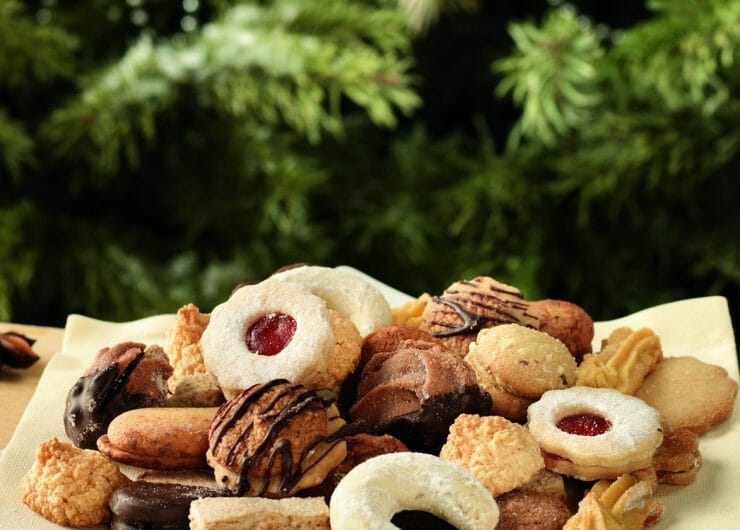
Biscuits and gingerbread
Vanilla crescent biscuits, Spitzbuben biscuits, nut macaroons, rum balls, coconut kisses and cinnamon stars: In SalzburgerLand, Advent is a particularly sweet time. Things are stirred, baked and decorated until the oven hums. The biscuits come out on the Advent days – and of course on the Christmas holidays. Where the tradition of biscuit baking comes from is not clear. One theory says that already in the Middle Ages, in the monasteries, biscuits were baked with fine ingredients and expensive spices to distribute them to the poor at Christmas. Today, biscuit baking is so popular that there are also children’s and adult courses in many places.
Special tips from the land of Silent Night:
- In the Lungau region of Salzburg, organic farmer, author and blogger Christina Bauer offers cookie-baking courses in Tamsweg.
- The Stille Nacht Manufaktur in Oberndorf offers “Stille Nacht Pralinés“, finest chocolates with an elegant nougat brittle filling and a hint of orange.
- In the Silent Night village of Hallein, the Confiserie Braun is a real insider’s tip: The in-house creations include, among other things, the Celtic disc brooch made of chocolate or the “Silent Night Mauserl”.
Elisen gingerbread
Ingredients for about 30 pieces
70 g butter
150 g raw cane sugar
2 organic eggs
1 teaspoon cinnamon
1 tablespoon cocoa
1 knife tip clove powder
grated peel of 1 organic lemon
100 g of candied lemon peel
100 g of candied orange peel
100 g raisins
200 g hazelnuts and/or almonds, ground
250 g wheat flour type 405
1 packet of baking soda
1/8 l of milk
round baking wafers (Ø 7 or 9 cm)
Chocolate icing
Stir the butter, sugar and eggs until frothy. Add cinnamon, cocoa, cloves and the lemon peel. Chop the lemons, orange and raisins and mix in. Add the ground nuts, the flour and the baking powder, and then add the milk.
Now spread the gingerbread mass about 1 cm thick on round wafers. Place the gingerbread on a prepared baking tray and bake slowly at 160°C for about 20 to 25 minutes.
Cover the cooled gingerbread with chocolate or sugar glaze and decorate it with halved, peeled almonds.
The traditional Kletzenbrot – Christmas fruit bread
Dried pears are also called kletzen in the land of Silent Night. And they lend the name to Kletzenbrot. In this delicious fruit bread, you’ll find everything that nature has to offer just before the onset of winter: rye and wheat flour, nuts, dried pears and raisins as well as all sorts of spices like cinnamon, cloves, anise and fennel. Farmers already baked Kletzenbrot hundreds of years ago as a nutritious winter food to provide enough energy during the cold season. Children usually take longer to warm up to Kletzenbrot because it is not particularly sweet in taste.
This Christmas classic is baked early in Advent, because the longer the bread rests, the juicier it becomes. It is eaten for afternoon coffee with a thick layer of butter or with ripe mountain cheese, as is the custom in the Gastein valley in SalzburgerLand.
Recipe for 4 to 5 Kletzenbrot breads
For the filling:
500 g kletzen (dried pears)
500 g raisins
500 g whole hazelnuts
20 g of candied orange peel
1 heaped tsp ground cinnamon
1 heaped tsp ground cloves
2 package vanilla sugar
grated peel of an organic lemon
125 ml rum
1 pinch of anise
1 pinch of fennel
1 big handful of raw cane sugar
For the dough coating and the fruit dough:
1 kg of rye flour type 610 or 997
1 kg wheat flour type 405
2 cubes of yeast (84 g)
1 tablespoon salt
1 pinch of sugar
1 tablespoon oil
lukewarm water
Boil the pears on the first day until soft, allow to cool and weigh. Mix all the ingredients for the filling and let the mixture rest overnight. If necessary, add a small amount of the boiling water from the pears to the filling.
On the next day, prepare the bread dough. Mix together all the ingredients in a large bowl. Add enough lukewarm water in small quantities until a smooth, firm dough is formed by vigorous kneading. Let the dough rest for an hour, then knead again.
Now weigh the fruits for the filling and divide into four to five equally heavy portions. With each fruit portion, knead 300 g of bread dough and shape it all together into a loaf. Make four to five loaves this way. Roll the remaining dough bread dough thinly flat, cut into the same number of pieces as you made bread loaves and wrap around the loaves, covering them completely. Let the covered loaves rest again for 20 minutes.
Pre-heat the oven to 180 degrees celcius. Brush the bread with oil and pierce the dough with a fork. The fruit loaves are baked for one hour with a (fireproof) bowl of water placed in the oven.
In case any dough is left, you can bake simple bread loaves with it.







